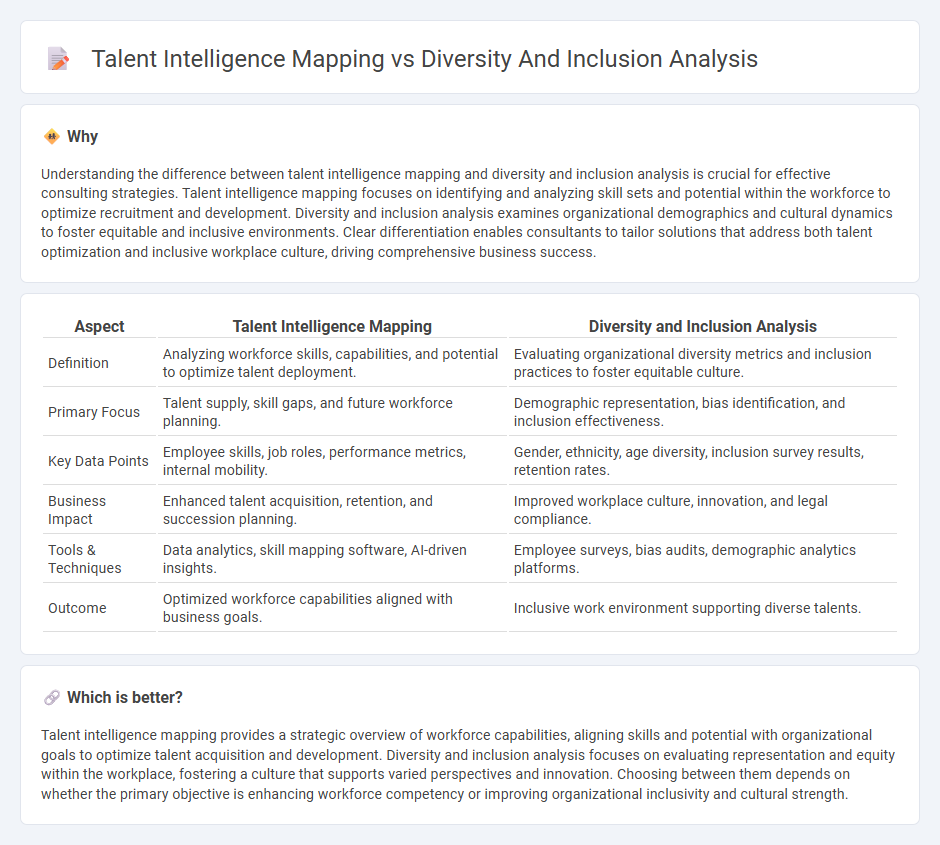
Talent intelligence mapping leverages advanced data analytics to identify and align workforce skills with organizational goals, enhancing strategic hiring decisions. Diversity and inclusion analysis assesses demographic representation and workplace culture, promoting equitable opportunities and fostering innovation through varied perspectives. Explore more to understand how integrating these approaches drives comprehensive talent strategies.
Why it is important
Understanding the difference between talent intelligence mapping and diversity and inclusion analysis is crucial for effective consulting strategies. Talent intelligence mapping focuses on identifying and analyzing skill sets and potential within the workforce to optimize recruitment and development. Diversity and inclusion analysis examines organizational demographics and cultural dynamics to foster equitable and inclusive environments. Clear differentiation enables consultants to tailor solutions that address both talent optimization and inclusive workplace culture, driving comprehensive business success.
Comparison Table
| Aspect | Talent Intelligence Mapping | Diversity and Inclusion Analysis |
|---|---|---|
| Definition | Analyzing workforce skills, capabilities, and potential to optimize talent deployment. | Evaluating organizational diversity metrics and inclusion practices to foster equitable culture. |
| Primary Focus | Talent supply, skill gaps, and future workforce planning. | Demographic representation, bias identification, and inclusion effectiveness. |
| Key Data Points | Employee skills, job roles, performance metrics, internal mobility. | Gender, ethnicity, age diversity, inclusion survey results, retention rates. |
| Business Impact | Enhanced talent acquisition, retention, and succession planning. | Improved workplace culture, innovation, and legal compliance. |
| Tools & Techniques | Data analytics, skill mapping software, AI-driven insights. | Employee surveys, bias audits, demographic analytics platforms. |
| Outcome | Optimized workforce capabilities aligned with business goals. | Inclusive work environment supporting diverse talents. |
Which is better?
Talent intelligence mapping provides a strategic overview of workforce capabilities, aligning skills and potential with organizational goals to optimize talent acquisition and development. Diversity and inclusion analysis focuses on evaluating representation and equity within the workplace, fostering a culture that supports varied perspectives and innovation. Choosing between them depends on whether the primary objective is enhancing workforce competency or improving organizational inclusivity and cultural strength.
Connection
Talent intelligence mapping leverages data analytics to identify skills, experience, and potential within diverse candidate pools, enhancing strategic workforce planning. Diversity and inclusion analysis evaluates demographic and cultural representation, uncovering gaps and opportunities that improve organizational culture and performance. Integrating these approaches enables consulting firms to craft comprehensive strategies that optimize talent acquisition and foster inclusive environments for sustained competitive advantage.
Key Terms
**Diversity and Inclusion Analysis:**
Diversity and Inclusion Analysis evaluates workforce composition to identify representation gaps across gender, ethnicity, age, and other demographic factors, aiming to foster equitable workplace environments. This analysis uses metrics such as pay equity, promotion rates, and employee sentiment to measure inclusivity and uncover systemic biases. Explore how Diversity and Inclusion Analysis drives strategic decisions to enhance organizational culture and performance.
Demographic Metrics
Diversity and inclusion analysis centers on evaluating demographic metrics such as race, gender, age, and ethnicity to ensure equitable representation and foster an inclusive workplace culture. Talent intelligence mapping integrates these demographic insights with skill sets, career trajectories, and performance data to strategically align workforce capabilities with organizational goals. Explore how combining demographic analytics with talent intelligence mapping can drive impactful workforce strategies and enhance diversity outcomes.
Equity Audits
Equity audits are critical tools in diversity and inclusion analysis, providing data-driven insights into workplace disparities related to race, gender, and other identity factors. Talent intelligence mapping complements these audits by visualizing workforce demographics and potential biases, enabling organizations to align hiring and promotion strategies with equity goals. Explore how integrating equity audits with talent intelligence mapping can drive meaningful inclusion initiatives in your organization.
Source and External Links
How to measure diversity equity and inclusion in workplace? - This guide explains how organizations can analyze demographic data, conduct surveys, and use inclusion metrics like turnover and pay equity to evaluate diversity and inclusion effectively.
Diversity, Equity, and Inclusion Analytics - This resource highlights integrating data across employee lifecycle stages and systems for a comprehensive DEI analysis including hiring biases, performance, and retention metrics.
Measuring diversity and inclusion in the workplace - It emphasizes the value of a DEI gap analysis to identify organizational deficiencies and systemic issues, informing strategic improvements and enhancing employee engagement.
 dowidth.com
dowidth.com